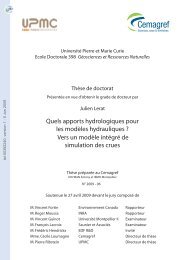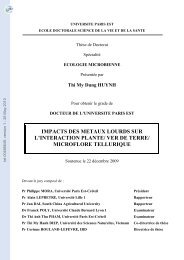La conservation de la nature en Afrique centrale entre théorie et ...
La conservation de la nature en Afrique centrale entre théorie et ...
La conservation de la nature en Afrique centrale entre théorie et ...
- No tags were found...
You also want an ePaper? Increase the reach of your titles
YUMPU automatically turns print PDFs into web optimized ePapers that Google loves.
tel-00508990, version 1 - 9 Aug 2010I.3. LA GESTION MONDIALE DES AIRES PROTEGEES .............................................................. ‐ 66 ‐L’Union mondiale pour <strong>la</strong> Conservation <strong>de</strong> <strong>la</strong> Nature .................................................. ‐ 66 ‐Une ava<strong>la</strong>nche d’acronymes… ...................................................................................... ‐ 68 ‐Les aires protégées transfrontalières (APTF) <strong>et</strong> les parcs pour <strong>la</strong> paix ........................ ‐ 70 ‐I.4. LES AIRES PROTEGEES D’AFRIQUE CENTRALE ................................................................. ‐ 72 ‐Des milliers <strong>de</strong> kilomètres carrés sur le papier ............................................................. ‐ 74 ‐Une coordination sous‐régionale très forte ................................................................. ‐ 75 ‐Des espaces africains sous haute surveil<strong>la</strong>nce… .......................................................... ‐ 79 ‐Aspects financiers ......................................................................................................... ‐ 83 ‐Les modèles <strong>de</strong> gestion <strong>de</strong>s Aires protégées d’<strong>Afrique</strong> C<strong>en</strong>trale .................................. ‐ 85 ‐I.5. L’AIRE PROTEGEE DEFINIT UN NOUVEAU TERRITOIRE… .................................................. ‐ 87 ‐EN RESUME… ....................................................................................................................... ‐ 89 ‐CHAPITRE 2 ................................................................................................................... ‐ 91 ‐PROJETS ET INITIATIVES DE CONSERVATION INTEGREE ................................................. ‐ 91 ‐II.1. LES INTERVENTIONS INTEGRANT CONSERVATION ET DEVELOPPEMENT ........................................ ‐ 93 ‐<strong>La</strong> protection d’espaces <strong>nature</strong>ls « sous cloche » perd <strong>de</strong> sa légitimité… .................... ‐ 93 ‐…Le tout participatif s’impose <strong>et</strong> <strong>de</strong>vi<strong>en</strong>t incontournable ........................................... ‐ 95 ‐Vers un Etat part<strong>en</strong>aire <strong>de</strong>s acteurs locaux .................................................................. ‐ 95 ‐Les « ICDPs » ................................................................................................................. ‐ 96 ‐Le <strong>la</strong>bel “CBNRM” ......................................................................................................... ‐ 97 ‐Les proj<strong>et</strong>s intégrés déçoiv<strong>en</strong>t… ................................................................................... ‐ 99 ‐Un modèle participatif peu convaincant .................................................................... ‐ 100 ‐Approche politique ou économique ? ......................................................................... ‐ 100 ‐II. 2. LES GRANDES TENDANCES SOUS‐REGIONALES DES INITIATIVES CBNRM .................................. ‐ 102 ‐Le rôle du secteur privé .............................................................................................. ‐ 102 ‐L’ancrage juridique ..................................................................................................... ‐ 103 ‐II.3. ANALYSE APPROFONDIE DES PROJETS CBNRM ................................................................... ‐ 106 ‐Les fon<strong>de</strong>m<strong>en</strong>ts <strong>de</strong> l’approche CBNRM : .................................................................... ‐ 106 ‐L’ancrage historique du CBNRM ................................................................................. ‐ 106 ‐Les limites <strong>de</strong> l’approche CBNRM, le déca<strong>la</strong>ge <strong>en</strong>tre pratique <strong>et</strong> rhétorique ............ ‐ 108 ‐Après le « tout participatif »....................................................................................... ‐ 112 ‐<strong>La</strong> portée du CBNRM <strong>en</strong> <strong>Afrique</strong> c<strong>en</strong>trale .................................................................. ‐ 113 ‐<strong>La</strong> valorisation touristique <strong>de</strong> <strong>la</strong> faune ................................................................... ‐ 114 ‐Les filières <strong>de</strong> vian<strong>de</strong> <strong>de</strong> brousse ........................................................................... ‐ 115 ‐Les échelles <strong>de</strong>s communautés ................................................................................... ‐ 115 ‐Les promesses non t<strong>en</strong>ues du pilier « empowerm<strong>en</strong>t » ............................................. ‐ 117 ‐Acteurs <strong>en</strong>dogènes <strong>et</strong> exogènes ................................................................................. ‐ 119 ‐EN RESUME… ..................................................................................................................... ‐ 121 ‐CHAPITRE 3 .................................................................................................................. ‐ 123 ‐UN REFERENTIEL JURIDIQUE COMMUN POUR EXPRIMER LA POSTURE DE LACOMMUNAUTE ENVIRONNEMENTALE ......................................................................... ‐ 123 ‐III.1. LE DROIT INTERNATIONAL DE L’ENVIRONNEMENT : NOTIONS DE BASE ..................................... ‐ 125 ‐III.2. LES TEXTES INTERNATIONAUX RELATIFS A L’ENVIRONNEMENT A FORCE OBLIGATOIRE .................. ‐ 126 ‐Ramsar (1971) ............................................................................................................ ‐ 126 ‐Conv<strong>en</strong>tion pour <strong>la</strong> protection du patrimoine mondial, culturel <strong>et</strong> <strong>nature</strong>l (1972) ... ‐ 130 ‐- 9 -
















